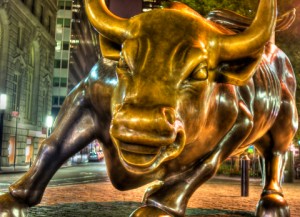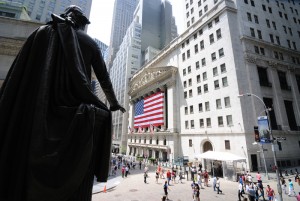
A stock is a share of ownership in a company that can be bought, sold, or traded as contrasted with a bond which is loan to a company that can be bought, sold or traded. Trading may have occurred as early as 9000 BC to 8000 BC when clay tokens were used for accounting and financial transactions.
From 4000 BC to about 3000 BC bulla came into use. This technology involved a clay purse with tokens that could be sealed. The tokens were, in essence, financial records. From approximately 2500 BC to 1800 BC writing on clay tablets (cuneifrom) in Mesopotamia became the financial transaction method of the day.
Mesopotamia was a thriving, and economically innovative culture. The region’s lack of natural resources naturally led to the elaborate creation of trading routes and systems. Agriculture, crafts, ranching, textiles, oils, precious gems, and grain were just some of the trade items which flourished.
In the Middle Ages in Europe, Euro-Fairs were agricultural and commodity centers which started to lay the groundwork for stock exchanges and banking operations. In Europe during the 1500s and early 1600s, exchange banks were formed in the Netherlands and in Italy to deal with currency exchange based on expanding trade.
Privately owned financial institutions developed simultaneously with state owned banks. Subsequently, the great banking families of the 1600s and the 1700s emerged in Europe: the Medicis, the Fuggers, and the Rothschilds. These families (and banks) were very effective at leveraging their wealth to dominate entire populations. They wielded power to control all aspects of the culture through cooperation or coercion. They were always revered for the power their money provided. Banking created even greater systems of commerce with even more effective strategies to facilitate power and control on regional and eventually global scales.
 Stock exchanges grew out of trading in commodities with an initial emphasis on agricultural products. As early as the 12th Century French commodity traders began to organize into groups to meet regularly and trade.
Stock exchanges grew out of trading in commodities with an initial emphasis on agricultural products. As early as the 12th Century French commodity traders began to organize into groups to meet regularly and trade.
In the Middle Ages traders began to use credit, notes, and ultimately bills of exchange. The first evidence of trading in government securities was seen in Venice in the 1200s. The Dutch East India company was the first company to actually issue shares of stock in 1606.
The brilliance and innovation of joint ownership enabled the Dutch to pool capital and finance huge shipbuilding enterprises which in turn propelled them into a position as the leading sea power of the era. The joint-stock corporation entity was the financial engine behind the Netherland’s ascension as a world power.
Interestingly, in the Dutch stock markets of the 17th Century there is evidence of stock options, stock futures, the use of credit (margin) to purchase shares, and even short selling. The market crashed in 1695, and we are also reminded of Tulip Mania in 1637 when a rare Tulip bulb had the equivalent value fo 12 acres of land (in a very small country). The Dutch do love their tulips.
The madness of crowds has long been part of the human psyche.
The oldest stock exchanges in the world originated in Europe: Antwerp Bourse, 1460; Lyons Bourse, 1506; Toulouse Bourse, 1549; Hambourg Bourse, 1558; and the London Royal Exchange, 1571. The Netherlands was the first country to issues stocks and bonds to the general public.
In 1602, the Amsterdam Stock Exchange was created. This followed from the Dutch East India Company’s model of allowing outside investors the right to purchase shares which entitled them to a percentage of company profits.
In 1773 the London Stock Exchange had its humble beginnings in the trading of shares in New Jonathan’s, a London coffeehouse, the first building to ever be known as a stock exchange. In 1802, the formal name London Stock was granted. It was made up of 500 subscribers and 100 clerks.
Stocks became known as funds allocated by a company or government from its capital for the purposes of financial investment and risk. This was quite a radical concept as value was distributed in a way that was not possible previously, and provided an even more robust means for growth.
Shares became known as equal parts into which a company’s stocks were divided for their purchase by an individual or another company who then became a shareholder and as such was entitled to a proportion of the company’s profits. Ordinary shares became known as equities.
The precursor to the New York Stock Exchange was created in Philadelphia in 1790. Here is where the first securities exchange was founded in the United States. In New York in 1792, a group of 24 brokers signed an agreement to meet at regular hours daily under and old buttonwood tree on Wall Street in lower Manhattan, New York City, to buy and sell securities.
The “Buttonwood Agreement” was etched on May 17, 1792 at 68 Wall Street. Initial offerings consisted of securities from five New York companies. At that point in time, Wall Street was also a popular place to buy and sell furs, tobacco, spices, molasses and gunpowder. The first listed company on the New York Stock Exchange was the Bank of New York, founded by Alexander Hamilton in 1784.
Hamilton was a brilliant and talented innovator who was our first Secretary of the Treasury, and an architect (he designed the Customs House at the foot of Bowling Green which houses the magnificent collection of American Indian art and artifacts). He also helped craft the founding of the National Bank and the United States Mint. And he was a gentleman farmer at Hamilton Heights, the site of the City University of New York in Harlem.
$80 million in United States Government bonds were the first publicly traded securities in this country. They were issued in 1790 to finance the American Revolution’s war debt.
The first commodities exchange in the United States originated in Chicago in 1848: the Chicago Board of Trade.
The small group of men who signed the Buttonwood Agreement revolutionized the country, and the world. After all, “New York IS the Financial Capitol of the World.” Like all markets the stock exchange grew to meet the needs of buyers and sellers of certain commodities to keep in close contact with each other. The sellers wanted to convert securities in to money and the buyers wanted to purchase particular securities. Interestingly, at first securities represented, for the most part, money loaned to governments. With the huge rise of American business corporations in the 19th Century, commercial securities came to dominate the volume of business transacted.
SOME STOCK EXCHANGE TRIVIA:
The highest price for a seat on the NYSE was paid in 1999: $2,650,000. The lowest price paid for a seat on the Exchange occurred in 1876 and 1878: $4,000.
Con Edison is the longest-listed company on the NYSE: in 1824 it was originally listed as the New York Gas Company.
The Dow Jones Industrial Average first closed over 100 in 1906, over 1,000 in 1972, and over 10,000 in 1999.
DARK, SOMBER, “FANTASTIC” MOMENTS IN WALL STREET HISTORY:
March 14, 1907: The San Francisco earthquake (foreshadowing Fukushima?) set the stage for the crash of 1907. The Dow lost more than 8%, closing at 76.23. A combination of inflated interest rates and land values fueled the panic of 1907.
October 24, 1929: On Black Thursday NYSE shares plummeted. Panic prevailed and $5 billion evaporated as 13 million shares traded. This meltdown “began” the Great Depression which lasted until World War II.
October 28, 1929: The Dow fell 13%, a record loss. The modicum of confidence that glimmered the week before was gone.
October 29, 1929: Black Tuesday! Confidence tumbled. The ticker tape lagged by nearly two hours. 16 million shares were traded, a record which held for 4o years. The Dow finished with a 12% loss.
July 8, 1932: The Dow closed at 42.22, an 89% drop from its peak. Confidence was dealt a new, low blow. The “New Deal” was about to be launched.
October 19, 1987: The Dow fell 22% (508 points). Hong Kong fell 45.5%. Australia fell 41.8%. Spain fell 26.5%/ Britain fell 26.5%, and so forth and so on.
September 17, 2001: After a four-day closure triggered by the 9/11 attacks, stocks plunged to three-year lows, nearly 7%.
February 27, 2007: Known as the “Chinese Correction,” the SSE Composite Index of the Shanghai Stock Exchange fell 9% triggering major drops in world markets.
September 15, 2008: The fall of Lehman Brothers (with more than $600 billion in assets) became etched as the largest bankruptcy in American history together with the “fire sale” of Merrill Lynch (the country’s largest brokerage firm) culminating in a 504 point loss in the Dow. And! AIG was “provided” with an $85 billion credit line by the United States government. Quite a day.
September 29, 2008: The Dow dropped 400 points in ten minutes; more than $1.2 trillion evaporates from the market. The House of Representatives was just not going to pass Bush’s $700 million bailout for financial institutions. “Six of one, half a dozen of another.”
May 6, 2010: The flash crash. The DOW drops nearly 1,000 points in intra-day trading before partially recovering.
Some rudimenary knowledge of stock exhange and banking history can strenghten the awareness, understanding, and voice of shareholders, investors, and shareholder activists. The invention of the stock market has been a fascinating process. Investment methodology and the creation of entire new fields of business and commerce have developed from these early, seeingly primitive beginnings. Bottom line: innovation cannot be contained. The human spirit is creative. Shareholders posses a nearly unlimited wealth of energy, a myriad of skill sets, and a healthy concern and respect for money.
To contact Christopher Bayer directly, please email Christopher.Bayer@TheShareholderActivist.com.








